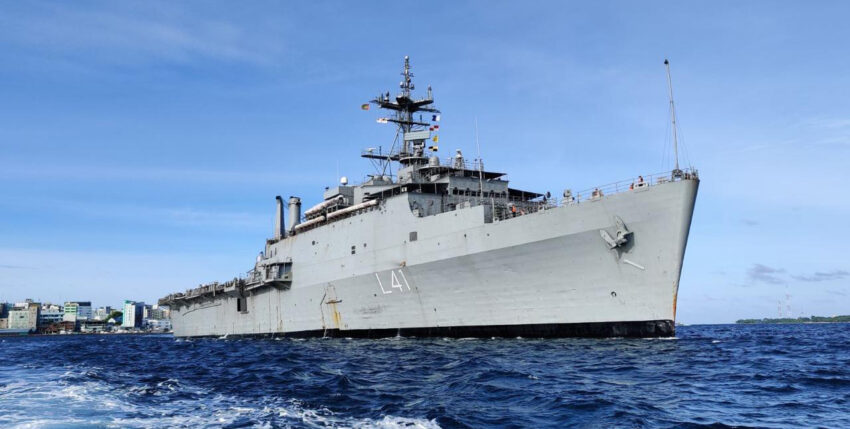With 1.4 billion people, India is the most populous country in the world and is home to the fifth largest economy in the world. Now New Delhi wants to join the global leadership club at a political and military level.
As a nuclear power and with extensive investments in modern conventional weapons, India is emphasising its global ambitions and its claim to a stronger role on the international stage. The government is pursuing a dual strategy aimed at consolidating its global role through increased international recognition while protecting and expanding its geopolitical and economic interests. A targeted expansion and diversification of bilateral and multilateral partnerships is an integral part of this strategy.
Regionally, New Delhi is trying to deepen partnerships in order to consolidate its claim as a regional leader and counter China's intrusion into India's traditional sphere of interest. This includes participation in regional cooperation forums in South Asia, including the South Asian Association for Regional Cooperation (Saarc) and the Bay of Bengal Initiative for Multi-Sectoral Technical and Economic Cooperation (Bimstec). The Act East Policy Initiative serves to strengthen economic and military relations with the Southeast Asian states, including through the construction of a comprehensive road network and the realisation of port infrastructure projects. Vietnam, the Philippines and other partners under pressure from Beijing are supported by arms deliveries and joint naval manoeuvres in the South China Sea. New Delhi has also expanded its maritime presence in the Indian Ocean in order to secure its own strategic interests and act as a guarantor of security in the region.
Globally, India is also seeking closer relations with the European Union. The world's largest democracy in terms of population is widely recognised as an important value partner and ally of Europe in strengthening the rules-based international order. A strategic partnership with the EU was agreed back in 2004 and a roadmap for intensifying it was presented in 2020. Key objectives include the expansion of dialogue on foreign and security policy issues of mutual interest, regular security consultations and the strengthening of military relations between India and Europe. An Indo-European rapprochement is also manifesting itself at a bilateral level. During his visit to India in 2023, Defence Minister Boris Pistorius called for the country to be treated as a strategic partner similar to Australia or Japan in order to facilitate defence cooperation and arms exports. On an economic level, India offers an alternative to China as a source of low-cost consumer goods.
Partnership with the USA
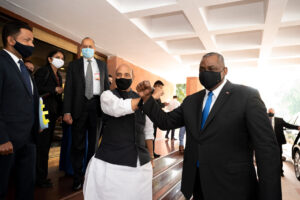
and his American colleague Lloyd Austin in New Delhi in 2021, photo: US DoD
Since 2008, there have been signs of a targeted rapprochement between New Delhi and the United States. Washington's recognition of the country as an important partner enhances New Delhi's global standing and strengthens India's influence in negotiations with smaller states in Asia, the Middle East and Africa. Both sides share an interest in curbing China's regional expansion. It is also increasingly beneficial for Washington to have a regional partner that can help stabilise crisis-ridden nations such as Bangladesh, Myanmar or Sri Lanka - above all to prevent Chinese influence in these countries. During his first visit to India in 2021, US Secretary of Defence Lloyd Austin described the relationship between the two countries as a "bulwark of a free and open Indo-Pacific region (...). India is an increasingly important partner as international dynamics rapidly change. I reaffirm our commitment to consolidating a comprehensive, forward-looking defence partnership with India as a core pillar of our policy in the Indo-Pacific region."
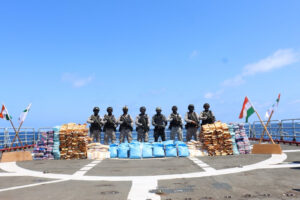
Intensified military cooperation is one of the main features of this development. New Delhi was therefore logically declared a leading defence partner of the USA in 2016. This classification, which is below the threshold of an alliance, enables deeper defence cooperation and the exchange of technology between the countries. On a practical level, the cooperation includes defence deliveries from the USA to India as well as bilateral military exercises for all branches of the armed forces. A logistics agreement concluded in 2016 enables Indian and American ships and aircraft to be supplied at each other's bases. In 2020, an agreement was initialled that grants India access to reconnaissance data from the US military. The maintenance of American warships at Indian shipyards was agreed in 2023. In the same year, the roadmap for defence industry cooperation between the two nations was agreed. This project, described as "ambitious" in Washington, provides for joint research and development as well as the production of army and air force weapon systems, among other things. There will also be cooperation in areas such as artificial intelligence, quantum computer technology and biotechnology. Washington hopes that this cooperation will not least remedy the current production bottlenecks for critical subsystems, from chips and semiconductors to aircraft engines.
Instrument of Indian foreign policy
All of India's armed forces are involved in expanding the various security partnerships, but the Navy is taking the lead. It is best placed to fly the flag globally and co-operate with foreign forces at the working level. Multilateral exercises and participation in international operations offer the best opportunities to raise India's profile as a security partner.
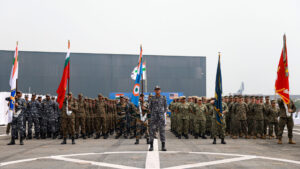
Since 2008, India has been involved in international operations to combat piracy and secure sea routes in the Gulf of Aden, in the neighbouring waters of the Arabian Sea and off the coast of Somalia. This presence includes regular sea patrols and escorting merchant ships, as well as the active rescue of hijacked ships. As part of these missions, Indian units regularly train and operate with European warships from the EU-led Operation Atalanta. Since November 2023, India has been a full member of the Bahrain-based multinational Combined Maritime Forces (CMF). Indian ships participate in the CMF's various Combined Task Forces operating in the north-west Indian Ocean, the Red Sea and the Gulf of Aden.
In addition, the Indian fleet provides bilateral support to smaller and less well-equipped countries bordering the Indian Ocean - including Sri Lanka, Mozambique, Madagascar and the Maldives - in developing coastal defence forces and monitoring their own waters and fishing zones.
India organises various large-scale multilateral exercises and participates in exercises led by other nations such as Rimpac. One of the most important maritime manoeuvres led by India is the Milan ("coming together") exercise series, which has been conducted in the Bay of Bengal since 1995. The manoeuvres, which were originally limited to five South Asian states, were gradually expanded. In 2024, the exercise took place with 35 ships with the participation of 15 nations and under the observation of 50 nations (including Germany).
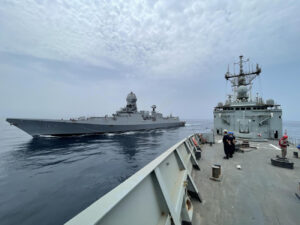
Frigate Numancia in the Gulf of Oman, photo: Eunavfor
Founded in 1992, the Malabar exercise series was originally a bilateral event organised by the Indian and American naval forces. The name reflects the fact that the manoeuvres mostly take place in the waters of the Malabar coast. In the meantime, Japan and Australia have also joined the manoeuvre series. The exercise areas have also been expanded and now range from the Persian Gulf to the waters of Japan, varying from year to year.
Malabar has thus de facto become part of the cooperation group known as the Quadrilateral Security Dialogue (Quad for short). This includes Australia, India, Japan and the United States. The official objective is to protect the free and democratic basic order in the region between the Indian Ocean and the Western Pacific. Despite this general formulation, there is no doubt that the primary task of the Group of Four is to prevent the expansion of Chinese influence in South-East Asia and the Indian Ocean. The smaller, democratically orientated states in the region are to be strengthened in order to resist pressure from China. The status of the Quad Group has been upgraded in the meantime. The heads of government of the four countries now meet annually to agree on a common course.
Practical cooperation between the Quad partners primarily takes place in the maritime domain. Security and stability in this strategically important region are to be promoted by maintaining free navigation and unrestricted trade. The exchange of data between the partners should serve to develop a comprehensive, up-to-date picture of the situation in these waters.
Focus on independence
However, India's willingness to cooperate and its commitment should not lead to exaggerated expectations of an Indo-US alliance or an operational partnership with NATO. New Delhi has no interest in being firmly integrated into the bloc. Rather, the aim is to expand its foreign and security policy options in order to promote its own national interests in a flexible manner without restricting its own freedom of action.

In this sense, New Delhi has so far resisted pressure from the US and Europe to condemn the Russian invasion of Ukraine. During and after the Cold War, Moscow was New Delhi's closest foreign and security policy partner - and consequently the primary source of Indian arms imports and technology transfers. Over the last 20 years, New Delhi has managed to reduce this dependency by increasing its own development and diversifying its external partnerships. However, this does not mean a break with Moscow, as demonstrated by Indian Prime Minister Narendra Modi's visit to Russia in July 2024. The fraternal embrace between Modi and Russian President Vladimir Putin in front of the cameras is unlikely to have been a spontaneous reaction. The official final declaration of the visit emphasised the ongoing "strategic convergence" of the two countries - in keeping with the warm welcome. It covers more than 70 areas in which bilateral cooperation is to be further intensified, including the transfer of military technology, cooperation in the UN and other international forums as well as space travel. Among other things, Moscow supports India's admission as a permanent member of the UN Security Council.
A fundamental continuity can also be seen in other forums. During the Cold War, India made a name for itself as the leading nation of the non-aligned states. This fundamental rejection of the concept of a world order dominated by the West has not changed. As a member of the Brics group (Brazil, Russia, India, China and South Africa) and the Shanghai Cooperation Organisation, New Delhi even works together with arch-rival Beijing to form a counterweight to the political and economic influence of the West.
Precisely because New Delhi sees itself as an independent actor, there is no fundamental contradiction in cooperating with Western nations when common interests are affected, for example by extremism and terrorism or by China's expansionist policies. India is perfectly capable of making a concrete contribution to containing these common threats. However, Western nations would be well advised to see co-operation as an alliance of convenience rather than fraternisation. India has achieved remarkable things in the last few decades and has the potential to excel. New Delhi is striving for recognition and respect from the West and at the same time wants to influence the security and economic situation in Asia, the Middle East and Africa to its advantage. This does not have to be a zero-sum game. America and Europe, Australia and Japan can certainly benefit from co-operation as long as it is approached with open eyes and without naivety.
Sidney E. Dean

